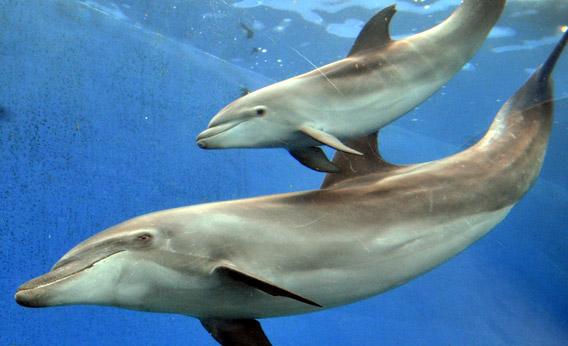 Is giving birth easier for nonhuman animals?
Is giving birth easier for nonhuman animals?Photograph by Yoshikazu Tsuno/AFP/Getty Images.
A new video showing a dolphin giving birth has been called ?a balm? for animal lovers grieving over the baby panda who recently died at the National Zoo. The Los Angeles Times noted that ?the newborn dolphin appeared healthy, lively and playful after it emerged? while one of her caretakers complimented the mother?s ?calm, relaxed nature throughout the whole entire situation.? Is giving birth easier for nonhuman animals?
It depends on the animal. While the combination of long labor times, big infant heads, and narrow maternal hips is often cited as a particular challenge for human mothers, some other mammals face difficulties that may be just as painful. One factor that can make labor more challenging is the size of the fetus relative to the mother. If a 140-pound mother gives birth to a 7-pound infant, then that infant represents about 5 percent of her body weight. On the other hand, when a 1,000-pound horse gives birth to a 100-pound foal, that foal represents 10 percent of her body weight, or twice as much. It?s impossible to quantify exactly how much pain this causes, but giving birth to larger offspring tends to be more dangerous and to result in more tearing. For other animals, the size of the offspring isn?t as big a problem. Litter-bearing species pass more offspring, but each infant tends to be pretty small. In pigs, a full-size sow might weigh 600 to 800 pounds, but her piglets might weigh only about 1 pound, or less than 1 percent of her weight.
Most nonhuman mammals tend to hide while giving birth, presumably to avoid attracting predators during their time of highest vulnerability. But while they may keep their pain more private, it?s known that many animals show some signs of pain and distress. During labor, horses sometimes sweat, llamas and alpacas bellow or hum in a way similar to when they are injured, and many animals become more aggressive. Veterinarians recommend that you exercise caution when approaching an animal in labor, as she may lash out. Even with poultry, facial expressions change when they?re laying eggs, though it?s unclear exactly what they?re feeling.
Labor times for other animals tend to be much shorter than for humans. It can take more than 24 hours for a woman to give birth, but dogs go through labor in about an hour. Cattle take about two to three hours. Horses can give birth within 30 minutes, but with great force; if the foal isn?t positioned correctly, the uterus may rupture.
When it comes to the relative size of newborn craniums, humans are not unrivaled. While most apes have ample pelvises for bearing their offspring, many other primates are not so lucky. Squirrel monkey infants have such large heads compared to the size of their mothers? pelvises that they face a very high rate of birth complications.
Perhaps the most horrifying birth is that of the spotted hyena. Females of this species give birth through a narrow, penis-like, enlarged clitoris. Their offspring emerge from this unusual birthing organ, almost indistinguishable from the male penis of the species, after 120 days of gestation. This unusually long period of development for a predator results in offspring that are comparatively large and fully ready to kill, with their sharp teeth completely emerged through the gums. The penis-like genitalia often rip open during the process of giving birth, which can be deadly for both the mothers and their cubs. One scientist has estimated that up to 18 percent of first-time mothers die.
Got a question about today?s news??Ask the Explainer.
Explainer thanks David Haig of Harvard University, Michelle Kutzler of Oregon State University, and Karen Rosenberg of the University of Delaware.
Source: http://feeds.slate.com/click.phdo?i=e1f2ace574238e5b9b29f726a25ca43d
food network good friday f/a 18 f 18 crash virginia tenebrae the lake house petrino arkansas
No comments:
Post a Comment
Note: Only a member of this blog may post a comment.